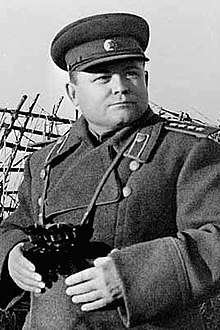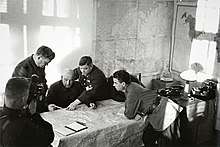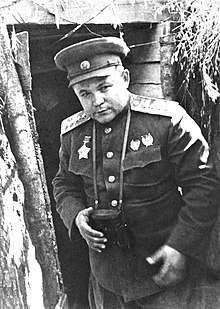Nikolai Vatutin
Nikolai Fyodorovich Vatutin (Russian: Никола́й Фёдорович Вату́тин; 16 December 1901 – 15 April 1944) was a Soviet military commander during World War II. Vatutin was responsible for many Red Army operations in Ukraine as commander of the Southwestern Front,[1] and the Voronezh Front during the Battle of Kursk.[2] During the Soviet offensive to retake right-bank Ukraine, Vatutin led the 1st Ukrainian Front, responsible for the Red Army's offensives to the west and south-west of Kiev and the eventual liberation of the city.[3]
Nikolai Vatutin | |
|---|---|
 Vatutin in 1943 | |
| Native name | Никола́й Фёдорович Вату́тин |
| Born | 16 December 1901 Chepukhino, Voronezh Governorate (now in Belgorod Oblast), Russian Empire |
| Died | 15 April 1944 (aged 42) Kiev, Ukrainian SSR, Soviet Union |
| Allegiance | |
| Years of service | 1920–1944 |
| Rank | Army General |
| Commands held | |
| Battles/wars | |
| Awards | Hero of the Soviet Union Order of Lenin (2) |
| Children | Elena (1930–?) Viktor (1932–?) |
| Relations | Tatiana Romanovna Vatutina (wife) Jelena (daughter, 1930–2016) Viktor (son, 1932–?) |
| Signature |  |
He was ambushed and mortally wounded in February 1944 by the Ukrainian Insurgent Army.
Before World War II
Vatutin was born in Chepukhino village in Voronezh Governorate (now Vatutino in Belgorod Oblast), into a peasant family of Russian ethnicity.[4] Commissioned in 1920 to the Red Army, he fought against the Ukrainian peasant partisans of Nestor Makhno. The following year, he became a member of the Communist party, and served diligently in junior command positions. Starting in 1926, he spent the next decade alternating service with studies in the elite Frunze Military Academy and the General Staff Academy. The 1937–1938 purge of Red Army commanders opened the road to promotion – in 1938, he received the rank of Komdiv, and was appointed Chief of Staff of the important Kiev Special Military District. Throughout this period, Vatutin combined military service with intensive Party activities.
In 1939, Vatutin planned operations for the Soviet invasion of Poland with Germany, and served as Chief of Staff of the Red Army Southern Group. In 1940, under the command of Georgy Zhukov, this group seized Bessarabia from Romania. As a reward for these non-combat campaigns, Stalin promoted Vatutin to the rank of Lieutenant General and appointed him to the critical post of Chief of the Operational Directorate of the General Staff. Vatutin was, however, not up to his new appointment: while innovative and hard-working, he lacked any combat experience and his knowledge of operational art and strategy was too abstract. Still, his peasant roots, relative youthful age, and party zeal made him one of Stalin's few favorites in the Soviet military. Vatutin, together with the rest of the Red Army high command, failed to prepare the army for the German attack of 22 June 1941.
On 30 June 1941, he was appointed Chief of Staff of the North-Western Front, which enabled him to exercise his better qualities. In this role Vatutin did not try to claim success for himself in battles, but made a point of identifying and promoting talented subordinates. He was notable for his audacity. At that stage of the war, most of the Soviet generals, shattered by defeats, were reluctant to carry out offensive operations, but Vatutin thrived on attack.
The Battles in the North

The Northwestern Front was defending Leningrad against approaches by the German Army Group North, spearheaded by armored corps led by Erich von Manstein. Vatutin took command of the Soviet forces near Novgorod and rallied them for offense, attempting to encircle a large German force. He surprised Manstein, put him on the defensive, and forced the entire German Army Group North to regroup its troops to halt the Soviet offensive. The Wehrmacht lost the precious summer season needed for an effective attack on Leningrad, while the Red Army got additional time to strengthen the fortifications of the city. Due to this, the Germans failed in their best shot to capture Leningrad, one of the key German strategic failures during the early phase of war. Vatutin's immediate operational results were far less impressive. Vatutin overestimated the capacities of his troops and created overly ambitious objectives, while his coordination of his forces and control over the unfolding of the battle were poor. Additionally, he did not take into account the difficult terrain which benefited German defenses and slowed his attack. Vatutin's casualty figures were staggering, in one army nearly reaching 60%. The ineptitude of his subordinate commanders exacerbated Vatutin's own shortcomings. One striking exception to this pattern of deficiency was the brilliance of Ivan Chernyakhovsky, an obscure young Colonel in command of the 28th tank division. The men had much in common, most prominently their penchant for unorthodox approaches to military art; they soon became close friends.
In January 1942, during the Soviet winter offensive following the Red Army victory in the Battle of Moscow, Vatutin's forces trapped two German corps in Demyansk, and achieved the first large Soviet encirclement of German forces. The German and Soviet armies were equal in size. During the battle, Vatutin employed innovative tactics and actions, while the Germans responded more conventionally. The Red Army was unable to destroy the German defenses, mainly due to the weakness of the Soviet air-force. In April 1942, Vatutin finally breached the German lines, just as a German relief force arrived. However, post-World War II American experts have evaluated the result of this operation as a draw. The German command drew self-congratulatory and misleading lessons from their narrow escape, concluding that they could overcome Soviet encirclements with supplies from the air while mounting a relief operation. This thinking contributed to the Wehrmacht disaster at Stalingrad.
Voronezh and Stalingrad

From early May to July 1942, Vatutin served briefly as deputy of the Chief of the General Staff of the Red Army until the German Army Group South embarked on its huge strategic offense, "Operation Blau". Initially, the German assault focused on Voronezh. They wanted to breach the Soviet front line at the Battle of Voronezh and then attack the Soviet Southern Front and Southwestern Front from the rear. On 1 July 1942, Stalin sent Vatutin as an all-powerful Stavka representative, to the critical Bryansk Front, which within a few days was renamed as Voronezh Front and placed under Vatutin's command.
During the battle, Vatutin again met Ivan Chernyakhovsky, now the newly appointed commander of the 18th Tank Corps of the 60th Army. The German attack was on the verge of breaching the Soviet front line when Cherniakhovsky's corps arrived by train. Cherniakhovsky unloaded one of his brigades and, without waiting for the rest of his troops, led that brigade against the German forces, throwing them back. After this action, Vatutin asked Stalin to give command of the 60th army to Cherniakhovsky. Initially, Stalin opposed the request, mostly because he had reservations about appointing such a young general to lead a field army. However, Vatutin finally convinced Stalin to promote Cherniakhovsky, who would rapidly rise to become one of the major Red Army field commanders.
Although the Germans captured the city, their attempt to breach Vatutin's front line failed. Following this, the Germans abandoned their initial plan, and shifted their efforts toward Stalingrad. On 22 October 1942, Vatutin received command of the newly formed Southwestern Front and played an important role in planning the Soviet counter-offensive and the following encirclement of the German 6th Army in the Battle of Stalingrad. In December 1942, to secure the Soviet ring around Stalingrad, Vatutin's forces encircled and destroyed two-thirds of the 130,000-strong Italian 8th Army in operation Little Saturn, contributing to the defeat of Manstein's Operation Wintergewitter ("Winter Storm"), the relief effort for the 6th Army.
Kharkov and Kursk
In January 1943, Vatutin's Southwest Front drove the Germans from Eastern Ukraine. His actions enabled the Voronezh Front under General Filipp Golikov to capture Kharkov, but he overextended his depleted troops and did not pay enough attention to the changing strategic situation. In February 1943, Manstein, using the forces extricated from the Caucasus, managed to surprise and defeat Vatutin south of Kharkov, leading to the encirclement of Golikov's advance troops in Kharkov, and the recapture of the city in the Third Battle of Kharkov. Stavka removed Golikov from his command, but did not see Vatutin's debacle as significant. For his audacity, Stalin awarded Vatutin the rank of Army General.
On 28 March 1943, Vatutin took command of the Voronezh Front, preparing for the momentous Battle of Kursk. At Kursk, he rejected conventional echeloning of armies; his innovative deployment allowed him to not only skillfully conduct the defense against the technically superior Germans, but also to quickly switch from defense to offense. Following the Soviet victory at Kursk, Belgorod was recaptured.
Kiev and the Korsun-Cherkassy pocket
Vatutin now aspired to retake Kiev. He regrouped his forces and surprised Manstein, sweeping tank forces through swampland and scattering the Germans from the unexpected direction. On 6 November 1943, Kiev was retaken. Vatutin relentlessly exploited his victory in Kiev, and pushed deep into the German defenses, destroying the German defensive line. However, Vatutin overextended his armies, and Manstein used his reserve forces in the XLVIII Panzerkorps to counterattack. In the battle of Radomyshl (6–15 November 1943) and the battle of the Meleni pocket (16–23 December 1943) Manstein unleashed successful counterattacks which took terrain back and inflicted heavy losses on the Red Army forces.[5]
Regaining the initiative in winter weather, in January Vatutin's front and the 2nd Ukrainian Front of Army General Ivan Konev carried out the sudden encirclement of the Korsun salient at the Dneiper River in the Korsun-Shevchenko operation. Although Vatutin started the operation two days after Konev and his striking formation, and the 6th Tank Army was only recently formed, he achieved the element of surprise by committing his tanks to the battle from the first echelon and once again attacking from unexpected terrain. This allowed the 6th Tank Army to penetrate deep into German defenses and, on 3 February, it linked with the advancing armor of Konev's front and trapped 56,000 German troops. By 17 February, Vatutin and Konev's forces had eliminated the Korsun-Cherkassy Pocket, although many of the encircled troops managed to escape.
Death
On 28 February 1944 Vatutin, regrouping for a new operation and heading to Slavuta (Khmelnytskyi Oblast), was ambushed by Ukrainian Insurgent Army (UPA) insurgents far behind the front lines near the village of Mylyatyn in Ostroh Raion (Rivne Oblast). He succumbed to his injuries from sepsis in a hospital at Kiev six weeks later. Vatutin's brothers, Afanasy Fyodorovich and Semyon Fyodorovich, were killed in action in February and March 1944; his mother, Vera Yefimovna, buried her three sons in two months.[6] Nikolai Vatutin was given a state funeral in Kiev. He was succeeded by Georgy Zhukov.
Legacy
His influence on the Red Army strategic planning, operational, and tactical techniques continued even after his death. Following the post-Cold War decline in Germanocentric analyses of the Eastern Front, Vatutin has won recognition among Western military experts as one of World War II's most creative commanders.
In 2015, Vatutin's daughter announced that her father had been buried in Kiev by Khrushchev against her family's wishes, and that his surviving family (who live either in Russia or in the Czech Republic) will attempt to obtain permission to rebury him in Moscow. The primary reason was stated to be their dislike for the new Ukrainian government's association with Stepan Bandera, whose followers had killed Vatutin. Originally, a press release from the Just Russia party had falsely claimed that the initiative to move his body had come from the Kiev authorities.[7][8] The reburial didn't materialise and Vatutin remains buried in front of his statue near the Ukrainian parliament.[9]
Popular culture
- Vatutin is supposedly related to a KGB officer in Tom Clancy's novel The Cardinal of the Kremlin.
- The battle of the Korsun Salient is the basis for the award-winning computer wargame Decisive Battles of WWII: Korsun Pocket.
References
- Keegan, pp. 106–107
- Keegan, pp. 124–125
- Keegan, pp. 126–127
- Герой Советского Союза Ватутин Николай Фёдорович :: Герои страны. Warheroes.ru. Retrieved on 16 May 2016.
- Newton, Steven H. (2005). Panzer Operations: The Eastern Front Memoir of General Raus, 1941–1945. Cambridge, MA.: Da Capo Press. pp. 256–262. ISBN 0-306-81409-9.
- Russian: Каманин, Н.П., "Летчики и космонавты", М, 1971, p.269 Some sources give the date of the attack as 29 February and the date of Vatutin's death as 15 April.
- Генерал Ватутин Киеву не мешает. Radio Svoboda. 12 April 2015.
- Dispute Rages Over Soviet General's Grave In Ukraine. Radio Free Europe/Radio Liberty. 11 April 2015.
- (in Russian) Monument to General Vatutin continue to stand outside the building in Kiev, Rada, RIA Novosti (30 June 2016)
Cited sources
- Keegan, John (ed.) (1996) Atlas of the Second World War. ISBN 0 7230 0939 2
Further reading
- David Glantz, "Vatutin" in Harold Shukman, ed., Stalin's Generals (New York, NY, 1993), pp. 287–298.
- David Glantz, Jonathan M. House, When Titans Clashed: How the Red Army Stopped Hitler (Lawrence, KS, 1995).
- David Glantz, Jonathan M. House, The Battle of Kursk (Lawrence, KS, 1999).
- David Glantz, The Battle for Leningrad, 1941–1944 (Lawrence, KS, 2002).
External links
| Wikimedia Commons has media related to Nikolai Vatutin. |